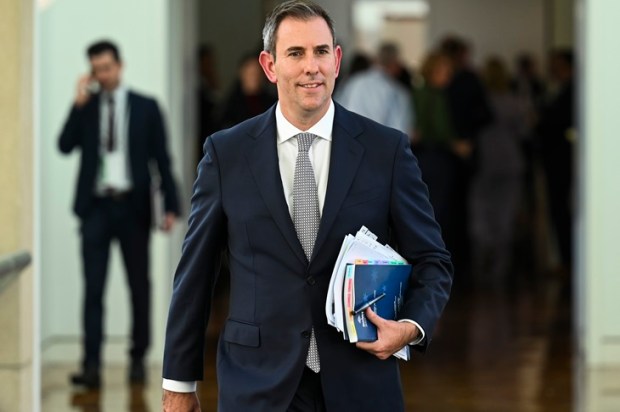Heavy hints from ministers that planned personal income tax cuts will be brought forward in next week’s budget have sparked debate about the bang-from-the buck from different types of fiscal stimulus. But there is much more at stake than that.
So much that The Australia Institute has seen fit to devote scarce think tank dollars to an orchestrated advertising campaign against any bring-forward of the tax cuts. Campaigns against new or increased taxes are not new, but a campaign against a tax cut must be a first. We have an organization campaigning against a (possible) government initiative to take fewer tax dollars from the citizenry. What is going on here? Those behind it may well be sincere in their beliefs -– but they are also mistaken.
According to the Institute’s campaign launch, “tax is an investment in our society”. This echoes the sentiment of the much-quoted words of Oliver Wendell Holmes that “taxes are what we pay for a civilized society”, but takes it further by characterising taxation as an “investment” — rather like modern politicians who routinely describe every type of government expenditure as an “investment” when in reality most of it is consumption or redistribution. “Investment” makes taxing and spending sound so much nicer.
Most people would agree with the Oliver Wendell Holmes version, but the question is how much tax is needed for a civilized society. The tax burden in nearly all countries has gone way beyond that point since Holmes made the statement in the 1920s. That brings us to the income tax cuts.
Recall that the Turnbull and Morrison governments in 2018 and 2019 announced staged tax cuts with delivery points in 2018, 2019, 2022 and 2024, the end-point being a 30 per cent marginal rate from $45,000 to $200,000. This involved an increase in the threshold for the existing 32.5 per cent rate from $37,000 to $45,000, a reduction in that rate to 30 per cent, abolition of the existing 37 per cent rate, and an increase in the threshold for the top rate of 45 per cent to $200,000. (To all of these rates must be added the Medicare levy of 2 per cent.)
This is a substantial and welcome reform of the personal income tax structure. It is a structural reform that will boost incentive and productivity for years to come.
However, under the current legislated phase-in, little of it will happen before 1 July 2022. The tax cuts before then take the form of a low- and middle-income tax offset, which is a complex design aimed at delivering the full benefits of the tax cut to incomes up to $90,000, a partial benefit up to $120,000, and no benefit at higher incomes.
As a means-tested tax cut, it was an interim arrangement aimed at letting the budget move into surplus in 2019-20 and then stay there. Given that goal, the government believed the full tax cut was unaffordable before 2024.
Now that surpluses are but a dream and the government not only tolerates but welcomes big deficits to support and stimulate the pandemic-struck economy, bringing forward the 2022 and 2024 stages of the restructuring is an obvious option.
However, the sky is not the limit, and choices still must be made. Given there are many ways to increase the deficit, is bringing forward the tax cuts among the most sensible?
There is much to be said for it. Given that the government has already won the political argument for the tax cuts, changing the timing is a relatively small step. True, it adds to the deficit for a few years, but it doesn’t add to the deficit permanently because the tax cuts were going to happen anyway.
There was always something ridiculous about a tax cut that wasn’t to be fully implemented for five years. Over such an extended horizon, there was always a risk it would never be fully implemented – and there is still a risk even though the legislation has been passed. If a week is a long time in politics, four years is an eternity. Bringing the implementation forward makes sure it will happen, because once the cut is fully implemented it becomes politically much harder to reverse.
The main objections to an accelerated implementation of the tax cut are that other forms of fiscal stimulus would be more effective in boosting consumer spending and employment; that the tax cut is ‘unfair’ because the future stages of it are skewed in favour of higher income earners; and that the cost in tax dollars foregone is too great.
Some other forms of fiscal stimulus might produce a larger increase in demand for goods and services in the economy in the short-term. But to make choices on that basis alone is to take a narrow Keynesian view of the world. Anyone that thinks Keynesian fiscal stimulus is the only key to revitalizing the Australian economy would be sorely disappointed at the results of such an approach.
The economy needed productivity-enhancing reform before the pandemic struck and it needs it even more now to counter the long-lasting damage the pandemic is doing to productive capacity. Personal income tax cuts should be viewed in that context, along with other needed reforms such as to industrial relations, regulation, and training for workplace skills.
A short-term bounce from the current economic distress is one thing. But just to get back to the mediocre growth path the economy was on before the pandemic – let alone a stronger growth path — is going to take several years of growth at rates that have not been sustained since before the GFC. Fiscal stimulus will not achieve that.
The legislated cuts up to 2024 deliver reductions in marginal rates at all income levels from $37,000 to $200,000. Reductions in marginal rates do wonders for incentives to work, improve, invest, and innovate. The low- and middle-income tax offset is an entirely different kind of tax cut which reduces effective marginal rates over some income ranges, increases them over some others and, in general, makes a complex mess of the income tax scale.
The claim that the tax cut is inequitable fails on a number of counts. It fails to view stages 1, 2 and 3 of the tax cut as a whole and to recognize that lower income earners were favoured in stage1; it fails to recognize that the tax cut as a whole has little effect on after-tax income distribution; and it fails to recognize that progressivity can only be sensibly assessed in terms of the tax-transfer system as a whole, not just any one part of it.
The reality is that underlying the Australia Institute’s campaign is a view that income tax and the entire tax-transfer should be more ‘progressive’. According to this view of the world, there is never a right time for a tax cut that benefits higher earners – not now, not in 2024, not ever. If the government announces a bring-forward in next week’s budget, the campaign will turn its attention to blocking the requisite legislation in the Senate. If no bring-forward is announced, we will see the case against the stage 2 and 3 tax cuts re-prosecuted before they are due to be implemented in 2022 and 2024.
As for the budgetary cost of the stage 2 and 3 cuts, to the extent anyone really cares about deficits now — and they should — John Humphreys has demonstrated that the true cost is likely to be much smaller than the government claimed and everyone else unquestioningly accepted. But in reality those opposed to the bring-forward don’t really care about the deficit — they just want the money for more ‘social spending’.
There is an overwhelming case to bring forward stages 1 and 2 for retrospective implementation from 1 July 2020, or failing that, then not later than 1 July 2021.
Robert Carling is a Senior Fellow at the Centre for Independent Studies.
Got something to add? Join the discussion and comment below.
Get 10 issues for just $10
Subscribe to The Spectator Australia today for the next 10 magazine issues, plus full online access, for just $10.


























Comments
Don't miss out
Join the conversation with other Spectator Australia readers. Subscribe to leave a comment.
SUBSCRIBEAlready a subscriber? Log in